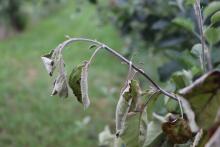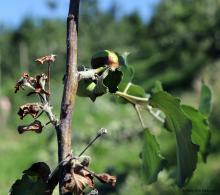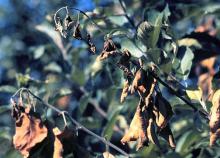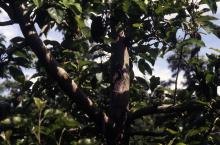See:
Pear (Pyrus spp.) - Fire Blight
Symptoms Several combinations of rootstock (M9 and M26) and cultivar (Braeburn, Fuji, and Gala) are very susceptible to fire blight. Trees may collapse without any sign of disease in the canopy. Disease symptoms can be confused with Phytophthora collar rot. Symptoms have been observed around the graft union area. Infection may spread from the collar to the roots or from the roots to the collar. Cankers near the base of the trunk often appear dark, water-soaked, and purplish on the outside. The margin may at first be indefinite or raised and blistered but becomes definite and marked by a crack or crevice later. When the bark is removed, the cankered area may show red-brown streaking. The younger the tree, the more likely the tree will die following infection.
Note: Resistant rootstocks can be used and include G. 11, 30, 41, 65, 202, 210, 214, 222, 814, 890, 935 and 969 in the Geneva series and Budagovsky 9 and 10.
Chemical note: In addition to those products listed in Pear (Pyrus spp.) - Fire Blight:
- The plant growth regulator Apogee is registered for apple only at 18 to 36 oz/A depending on tree size and vigor. The first application in Oregon and Washington can be made between pink and 1 to 3 inches new growth. This early application was found to help with both fire blight during bloom and early shoot growth. Results have varied in Western States. Not recommended for very young trees. Remove and replace 1- or 2-year-old trees, which have fire blight. Do not use within 45 days of harvest or with calcium sprays. May increase cracking of cultivars such as Empire or Stayman. 12-hr reentry.
- Lime sulfur used for fruit thinning will also help manage fire blight by reducing both bacterial populations and flowers. May injure fruit on 'Delicious' apples and is not for use on 'Ginger Gold'. Do not use biological control agents close to lime sulfur applications. 48-hr reentry. O
References Wallis, A. E., and Cox, K. D. 2020. Management of Fire Blight Using Pre-bloom Application of Prohexadione-Calcium. Plant Disease, 104:1048-1054.
Johnson, K.B., and Temple, T.N. 2013. Evaluation of strategies for fire blight control in organic pome fruit without antibiotics. Plant Disease 97:402-409.






